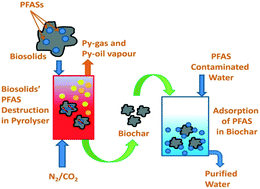Removal of PFASs from biosolids using a semi-pilot scale pyrolysis reactor and the application of biosolids derived biochar for the removal of PFASs from contaminated water†
Abstract
This study focuses on the conversion of biosolids to biochar and its further use in adsorbing per- and polyfluoroalkyl substances (PFASs) from contaminated water. In particular, this study aims to (a) investigate the performance of a semi-pilot fluidised bed pyrolysis unit in converting biosolids into biochar, (b) examine the ability of the pyrolysis–combustion integrated process to destruct PFASs present in biosolids and (c) study the application of biosolids derived biochar for removing PFASs from contaminated water. The semi-pilot fluidised bed pyrolysis unit demonstrated stable temperature and oxygen profiles in the reactor. The yield of biochar was found to be 36–45% at studied temperatures (500–600 °C). The produced biosolids derived biochar samples, due to their lower H/C and O/C ratio, were found to be extremely stable with an expected long (millennia) residence time in soil. It was concluded that >90% removal of perfluorooctanesulfonate (PFOS) and perfluorooctanoic acid (PFOA) from biosolids derived biochar could be achieved in the pyrolysis–combustion integrated process. The biosolids derived biochar demonstrated >80% adsorption of long-chain PFASs and 19–27% adsorption of short-chain PFASs from PFAS contaminated water.

- This article is part of the themed collection: Best Papers 2021 - Environmental Science: Water Research & Technology


 Please wait while we load your content...
Please wait while we load your content...